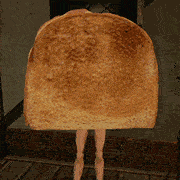|
Chichevache posted:I'm from the west coast and I use y'all. I admire the South for inventing a convenient and non-gender-specific form of addressing groups. It's far superior to the contemporary Californian use of "you guys". I use both y'all and dude, because as an ancient wise man once said, we're all dudes.
|
|
|
|

|
| # ? May 10, 2024 03:15 |
|
I like y'all/all y'all.
|
|
|
|
Only in Arkansas have I heard people unironically say "y'all all." Edit: Sorry for nudging it in that direction, but please nobody start another dialect derail.
|
|
|
|
Rollersnake posted:Only in Arkansas have I heard people unironically say "y'all all." it's ""all Y'alls"
|
|
|
|
Yous.
|
|
|
|
Yinz
|
|
|
|
Fellow humans!
|
|
|
|
You lot.
|
|
|
|
gently caress off
|
|
|
|
|
hay guyz what is goin on in this thraed
|
|
|
|
Powaqoatse posted:hay guyz what is goin on in this thraed
|
|
|
|
Lunchmeat Larry posted:im sucking dick again nice!
|
|
|
|
Tiggum posted:Yous.
|
|
|
|
You people.
|
|
|
|
burexas.irom posted:You people. The gently caress's this supposed to mean?!
|
|
|
|
Motherfuckers.
|
|
|
|
MODS CURE JOKES posted:i'm gonna loving buy a slab of estruscan limestone and carve it into latin magiscule "SED EMAILVS" and loving bury myself inside of it like some sort of retard sarcophagus
|
|
|
|
thanks for saving the thread
|
|
|
|
Just bring back thou.
|
|
|
|
Osama Dozen-Dongs posted:Just bring back thou. thou is familiar/singular also shut up Trumps Baby Hands posted:http://gawker.com/my-summer-job-at-the-bohemian-grove-serving-milkshakes-1763551409 Ron Jeremy posted:The boys are in the yard. They were promised milk shakes. WTF, service staff?
|
|
|
|
Skippy Granola posted:Don looks like someone tried to draw Tom Clancy from memory
|
|
|
|

|
|
|
|
TheWeepingHorse posted:Juan is the loneliest bomber that you'll ever know
|
|
|
|
Magic Hate Ball posted:My doofus ex once got violently upset with me for suggesting Cronenberg's films deal with our fear of illness and bodily function. FreudianSlippers posted:Doofus Ex: Manchild Incited
|
|
|
|
I don get the first or second part. Ima doofus
|
|
|
|
Burt Sexual posted:I don get the first or second part. Ima doofus did you ask for that though?
|
|
|
|
Burt Sexual posted:I don get the first or second part. Ima doofus What a shame
|
|
|
|
Improbable Lobster posted:What a shame yeah, rip.
|
|
|
|
Bip Roberts posted:I'm predator in the back there. Bear Retrieval Unit posted:Bill Clinton?
|
|
|
|
Tony Blair kind of looks like "whatcha gonna do?"
|
|
|
|
Ed: not worth it
|
|
|
|
The Glumslinger posted:Ed: not worth it Hey, let's not bash Ed while he's not here.
|
|
|
|
Space Cadet Omoly posted:I know, it's just, not peeing kills people. How is that not common knowledge? They might as well have had a "see how many knives you can fit in your stomach!" contest.
|
|
|
|
The Glumslinger posted:Ed: not worth it
|
|
|
|
Burt Sexual posted:I don get the first or second part. Ima doofus Powaqoatse posted:did you ask for that though? Improbable Lobster posted:What a shame RyokoTK posted:yeah, rip.
|
|
|
|
For many of us, a sandwich was the first meal we learned to make for ourselves. And we delight in eating them for the rest of our lives, sometimes at an astonishing rate—roughly 50% of Americans consume a sandwich every day. It is, after all, one of the most versatile, simple, and universally beloved foods we know, with countless variations to satisfy every palate, dietary restriction, and time of day. And yet, for all its ease and accessibility, the sandwich is not infallible. Even the most basic iterations, like the PB&J and grilled cheese, can go awry—and that's not touching on more labor-intensive preparations, like meatball subs or bánh mi. It takes only one disappointing sandwich, homemade or store-bought, to realize just how much can end up wrong. So how do you maximize flavor, manage sogginess, maintain structural integrity, and achieve the most well-balanced and delicious sandwich possible? I chatted with sandwich-making professionals around the country about the fundamental principles and best practices of sandwich construction, gathering their tips and tricks along the way. Whether you're looking for vindication that you've been doing it right all along, hoping to step up your game, or troubleshooting some common pitfalls, we've broken down the core components of the lunchtime staple, with expert recommendations for each and every one. Before we get started, it's worth noting that sandwiches cover an impossibly broad spectrum, so opinions vary widely regarding what constitutes a perfect sammy—and even what the true definition of "sandwich" is in the first place. For the purposes of this story, we focus primarily on closed-face, American-style deli sandwiches. Here's what the pros had to say. GET GOOD BREAD, AND MAKE IT EVEN BETTER any bread you're using for a sandwich should be delicious enough to eat on its own Starting with good bread is something our experts unanimously agreed on. "If you've got great bread, you've got a great sandwich—it really is half the battle," says Charles Kelsey, of Boston's Cutty's. In other words, any bread you're using for a sandwich should be delicious enough to eat on its own. Sometimes that means buying a high-quality artisan loaf in place of supermarket bread. That said, Kelsey adds, "You can take crappy bread and make it taste better." He recommends toasting it for starters, but if it needs an even bigger hand, he says you can't do better than griddling it with some butter. Your goal? Pane Bianco's owner, Chris Bianco, wants his bread "crisp enough to provide some structure to the foundation of the sandwich, but still yielding in the center." Even the best of breads can prove tricky if they're not handled properly—especially if they're thick. "The thing you don't want is to take a bite of a sandwich and have a wheat-infested smackdown in your mouth," says Jeff Mason, who runs Oakland, California's sandwich shop Pal's Take Away. Rather than plodding through a particularly thick roll, take a page out of Mason's book and "try carving out some bread from the dome of the roll. That way, you'll get an equal bump of flavor from the bread and the ingredients, instead of an overwhelming hit of one flavor over all the others." Mason's technique earns bonus points for also creating the perfect space for squishy or slippery ingredients that would otherwise tend to slide out of sub-style sandwiches: "The dome creates a little cave unit to house your ingredients," he says. But how do you choose when to go with a roll versus sliced bread, whether it's rye, white, or wheat? And when should you opt for a potato bun or a baguette? When it comes to selecting the right bread for your sandwich, I quickly learned that it's virtually impossible to make blanket generalizations, and a lot comes down to personal preference. One thing you can focus on, though, is its texture. "Bread can often satisfy the crunchier component of a sandwich," says Caroline Fidanza, from her Brooklyn sandwich shop, Saltie. Fellow Brooklynite Fred Hua, of Nhà Minh, agrees. "Crunch is a huge part of what makes a great sandwich. But think about balancing it with other textures. A crisp, crunchy, toasted bread can be a great vessel for something stewy—stewed vegetables or stewed beef." Tyler Kord, of New York's No. 7 Sub, also suggests looking to bread as a source of contrast. "If you're putting crunchy fried chicken in a sandwich, then I like a super soft white bread. And conversely, for a PB&J, something crunchy would be nice." Is it a universal rule, though? Hardly. Kord is quick to add: "Then again, an egg and cheese from a bodega [which is nearly always served on a soft, untoasted roll] has almost no texture, and it is one of the best, if not the best, sandwiches in the history of sandwiches." While a lot depends on the texture of the ingredients you're putting inside, volume can also play a role in bread selection. "I feel like on the softer breads, you can get away with more ingredients—that give means you're less likely to push your fillings out the back," says Kelsey. On the other hand, putting soft ingredients, like egg salad, on a super-crusty, chewy, dense bread can be a recipe for disaster, he notes. If you're not careful, it'll all squish out, so "you have to be more judicious about balance and the amount of filling that goes on a stiffer bread," Kelsey concludes. BETTER CONDIMENTS, AND MORE OF THEM I'd always imagined sogginess would be one of the main issues expert sandwich makers have to contend with, but I couldn't have been more wrong. Nobody I spoke to had a problem with soggy sandwiches—provided they're tasty. "Sometimes you embrace the sogginess," says Chicago-based chef Rick Bayless. "One of our most famous sandwiches is the torta ahogada, a famous dish from Guadalajara. It's a sandwich of shredded pork carnitas (with black beans and pickled onions), served in a bowl of spicy tomato broth. We serve both sides of the sandwich right in the broth. It softens the crunchy bread and no one's ever complained!" In fact, some sandwich makers choose breads that actually facilitate sogginess, including the ubiquitous potato roll. "The popularity of the Martin's potato roll is kind of fascinating," says Fidanza. "It turns into a mushy, soggy thing so quickly but it's so delicious that you kinda don't care." However, "a dry sandwich is the worst sandwich. If a sandwich can avoid being dry, that's step one." The crucial factor, she says, is condiments. Not only do they protect your sandwich from dryness, they make it taste a heck of a lot better, too. "A good sandwich comes down to the condiments," Fidanza says. "You can use anything—turkey, tuna, vegetables, a hard-boiled egg—as the base of a sandwich. But having good condiments to make them taste better is key, whether that's mayonnaise, mustard, or some kind of relish. It needs those elements to elevate the base." Kelsey couldn't agree more: When I asked him what can ruin a sandwich, he was quick to reply, "Not putting enough sauces or spreads on the sandwich," before rattling off some of his favorites, from olive oil to ranch dressing to barbecue sauce to more typical lubricants, like butter, mayo, and mustard. He's such a fan of sauce that he'll often use more than one on a single sandwich. To ensure that you get moist, flavorful bites, Kelsey recommends that you "put your mayo on both slices of bread, but try also adding some to the protein itself. I still probably use the same amount of mayonnaise, I just distribute it differently so there's better balance." Spreading butter or mayonnaise on your bread will help insulate and waterproof it from wetter ingredients like tomatoes Mayo and other fatty sandwich spreads can actually do double duty, adding moisture in the right places while preventing excessive sogginess in the wrong ones. "Water will dance off a fat," explains Bianco. "Spreading butter or mayonnaise on your bread will help insulate and waterproof it from wetter ingredients like tomatoes." All that mayo is also a great opportunity to experiment with flavor. "Don't hold back on spiking the mayo," says Hua. "We add garlic, turmeric, ginger, spices, curry, salt, olive oil—we throw in everything we can. It's about using it as a vessel for more flavor." Mason takes a similar approach to his spreads: "I take mayo and I flavor it with all kinds of things—sometimes I'll put soy and yuzu in there, sometimes I'll add lemon, or lime, or chili." He's also a fan of playing with other spreadable ingredients, like yogurt or tahini, which are easy to mix and infuse with seasonings. He even creates house cheese spreads—a fiery pimento-style cheddar, for instance, that gets smeared on his roast beef sandwich, along with barbecue sauce, a spicy yogurt-based slaw, and mayo. If this is all starting to sound a little too, well, fatty, you can also look to vinegar as a source of brightness and moisture. "Acid for a sandwich with cheese in it is always great," says Parm's Mario Carbone, "especially if you're toasting the bread and it can stand up to some vinegar or vinaigrette." He makes an Italian-style salad dressing for some of his sandwiches, but even a squeeze of lemon juice can go a long way toward cutting through a rich and creamy combination. TREAT YOUR VEGETABLES RIGHT After good bread, good vegetables were at the top of most pros' lists. But it's not just about buying fresh, flavorful ingredients. "Vegetables need to be washed," says Hua—even if they're already clean. "It'll really bring them back to life." And, once they're clean and crisp, don't hesitate to season them. "If you rinse your lettuce and let it dry until it's just slightly moist, it's great to give it a sprinkle of sea salt and freshly ground black pepper," Bianco adds. "The same goes for tomatoes." These steps may sound small, but they can do a lot to add bold, vivid flavor to every bite. Adding creamy-sharp slaws, spicy or tangy pickles, and long-marinated vegetables can also lend great brightness and contrast to otherwise ho-hum sandwiches. And, because these items store well, they don't necessitate a trip to the grocery store. If you can't track down the best and freshest version of a particular ingredient, try replacing it with something else. Instead of using mealy, bland winter tomatoes, Mason's a fan of roasting grape tomatoes during the colder months. "Buy a little carton of grape tomatoes and put them in a bowl with a little curry powder and a little salt and a tiny bit of olive oil," he suggests. Mason roasts them on a sheet pan in the oven for about half an hour at 350°F, until the tomatoes are lightly charred. Then he tosses the mixture with some sherry vinegar. "You can put them on almost anything. Since they've lost a lot of their water, they'll kind of stick." Hua also suggests trying out less sandwich-friendly vegetables to coax out new and unique flavors. "There's always a way to work an ingredient into a sandwich," he insists. "Take something like rutabaga. You think, what am I going to do with rutabaga? Well, you could cut it up real thin, you could pickle it, you could sauté it, you could make it into a marinated salad of some sort, you could pulverize it in a food processor and make a patty or even a flatbread." Moral of the story? Look beyond the obvious and you may just wind up with something truly special. PROTEIN DOS AND DON'TS I'm hard-pressed to think of a protein that doesn't belong on a sandwich, from fried chicken to tofu. But "whether it's ham or seitan, you'd be surprised by how much better a sandwich is when you heat up the protein," says Hua. "Even if it's just a prepared ham, it brings out a whole other level of flavor: the juices come out, the sweet, the savory, it all surfaces when you bring it up to temperature." And he's not picky about how you do it, either, even if it's by microwaving. Hua recommends covering your meat in plastic wrap, with a little vegetable stock or a slice of butter thrown in, and adding salt and pepper before putting it in the microwave. Or, if you're working with a pan, he says, "throw some oil on it—olive oil, sesame oil—that extra layer of flavor really changes everything." Even if you're shooting for a "cold" sandwich and don't feel like going to the trouble of heating something up,"you should take the chill off things—you shouldn't be afraid of leaving certain ingredients out to come up to room temperature," says Mason. That goes for condiments, cheese, and sliced deli meats, he adds. And, speaking of deli meats, "you can improve a sandwich 10,000-fold just by using thinly sliced meats, even when they're not high quality," says Kelsey, who jokingly calls thick, slab-like slices the Captain's Cut. "When they come off the slicer, if they're falling into flat planks like a deck of cards, instead of draping, you're in Captain's Cut territory," he says. "Too thin, on the other hand, they'll stick together in a sort of meat wad. You want the thickness where there's a little bit of chew, but they still melt in your mouth." Not sure how to get your hands on that perfect cut? Kelsey recommends making friends with your local deli counter employee and asking nicely; you can also seek out packages of presliced meat that specify a thinner cut. LAYER WISELY "A lot of people just throw everything on the sandwich like all the junk under their bed," says Hua. "The sequence makes a huge difference, though: certain things are meant to be on top of others." On this note, all experts seem to agree. But how and why they layer their ingredients is another matter entirely. Hua, for one, likes to layer by temperature, alternating hot products with cooler ones. You'll find the cheese beneath the protein and the garnishes above it on most of his sandwiches. "You don't want to bite into a sandwich that burns the top of your mouth and feels cold on the bottom," he explains. Fidanza, on the other hand, almost always places her featured element on the bottom. "Think about a burger," she says. "That patty is the prize; the garnishes need to go into your mouth first in order to really taste them, or they risk being bowled over by the meat product. If you eat a hamburger upside down, first you'd get the burger and then any condiment elements—it's jarring." Sometimes, though, you'll want to aim for something more symmetrical, says Kelsey. "If you're making a pressed sandwich, think about building a sandwich in mirrored layers, so the whole thing gets enveloped in the cheese from both sides." if it's bigger than your mouth, you're probably in a bad place for eating it. More is not better It all boils down to choosing the right ingredients and then portioning them thoughtfully. "It's sort of like pizza philosophy: you can easily overdo it," says Carbone. "You need to have some restraint in terms of how much you're putting onto a sandwich—if it's bigger than your mouth, you're probably in a bad place for eating it. More is not better." Having too many ingredients doesn't just make a sandwich hard to eat; it can also mess with flavor and balance. "You want to build the ingredients so that they don't impose on the next ingredient. Together they should be great, but you want to be able to taste them separately," notes Mason. Kelsey agrees. "You can put anything on a sandwich, but they might clash or cancel each other out. I always look for balance; if you're going to put something on a sandwich, you should be able to know that it's there and that it's complementing the other ingredients." Once you've nailed your ingredients, you also want to consider the sandwich's structural integrity. "For me personally, I hate when poo poo falls out of my sandwich," says Bianco. "You have to constantly be aware of the tectonic shift," adds Carbone. "The biggest offender of the tectonic shift is the sliced tomato: you stack two tomatoes on top of each other, they start to rub on each other, and then your sandwich is shooting across the room. Keep your tomato to your uppermost or lowermost portion of your sandwich. With tomato in the middle, you're asking for an earthquake." Mason's on the same page. "Don't layer two slick ingredients on top of each other, like mayonnaise and ham," he recommends. "If you make the sandwich and try to press it, it's going to squirt out. And when you bite it, it'll go everywhere." FOOD FOR THOUGHT At the end of the day, one thing every sandwich maker wanted to drive home was that sandwiches are personal, and there's no one correct way to approach them. Most important is making a sandwich that's filling and fulfilling. "The most satisfying thing about making a sandwich is cutting into it and seeing all the layers that went into it," says Hua. "That's what makes a sandwich taste good and look beautiful. It's like a yearbook of the efforts you've put into it—you can't help but take a little pride in it." The best sandwich is the one you like best So experiment with new flavors and textures—chips and pickles, unfamiliar vegetables, slaws and cheeses—but don't shy away from the qualities you like best. "Acknowledge that you already know twice as much as you think you do," says Bianco. "And then follow your instincts and make the sandwich that's right for you. The best sandwich is the one you like bes
|
|
|
|
Avshalom posted:For many of us, a sandwich was the first meal we learned to make for ourselves. And we delight in eating them for the rest of our lives, sometimes at an astonishing rate—roughly 50% of Americans consume a sandwich every day. It is, after all, one of the most versatile, simple, and universally beloved foods we know, with countless variations to satisfy every palate, dietary restriction, and time of day. same
|
|
|
|
Avshalom posted:For many of us, a sandwich was the first meal we learned to make for ourselves. And we delight in eating them for the rest of our lives, sometimes at an astonishing rate—roughly 50% of Americans consume a sandwich every day. It is, after all, one of the most versatile, simple, and universally beloved foods we know, with countless variations to satisfy every palate, dietary restriction, and time of day. If you have this much time to read a post about sandwiches, you have time to make an actual meal.
|
|
|
|
Sandwich? No thanks, I'll just have a hot dog.
|
|
|
|

|
| # ? May 10, 2024 03:15 |
|
Avshalom posted:For many of us, a sandwich was the first meal we learned to make for ourselves. And we delight in eating them for the rest of our lives, sometimes at an astonishing rate—roughly 50% of Americans consume a sandwich every day. It is, after all, one of the most versatile, simple, and universally beloved foods we know, with countless variations to satisfy every palate, dietary restriction, and time of day. Oh hey, what's up Arthur Dent, you ready for the next Perfectly Normal Beast stampede?
|
|
|





























 vs.
vs.

















